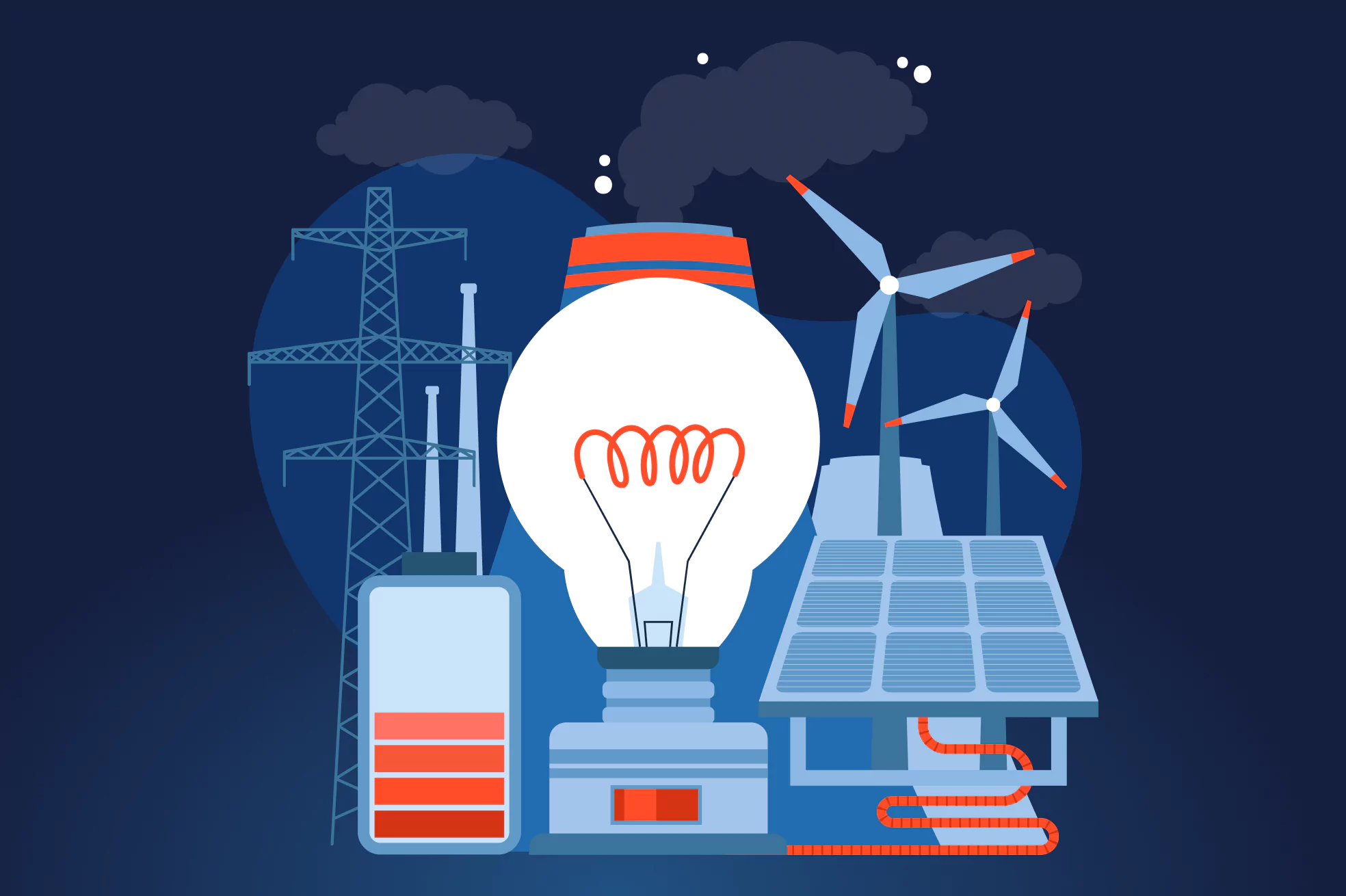Whether it’s a teacher from the United Kingdom or taxi driver from Lithuania, their lives have become tougher due to the soaring costs of energy. After Russia invaded Ukraine in 2022, people in Europe have become worried about their ability to keep the roof under their head and have been confronted with very hard choices. But while each day European residents are counting euros in their pocket when looking at their electricity bills, Ukrainians do absolutely the same, fighting for their freedom and the peace of the rest of the world simultaneously. Many European countries understand that if their support of Ukraine is strong, this crisis will not last long.
To get over this period with less pain, the world faced the need to shift from Russia’s natural gas and oil to renewable energy sources. From large corporations to newborn startups, everyone needs to step in to make their investments in energy solutions. In this blog post, the JatApp team is going to talk about using artificial intelligence (AI) in energy storage systems, which would, hopefully, help to make the full transition to clean energy possible in the near future.
What is battery storage?
Battery storage refers to the system charged by electricity that can be produced from renewable energy, such as solar and wind power. The battery storage system has the following key components: the battery (the Captain Obvious comes in), power conversion system, and monitoring and control systems. Cell-based batteries contain cells united into modules and packs.
Battery storage system’s components
Battery storage allows users to capture power, so that they can use it at another time. For instance, they can store the energy that their solar panels produce during the sunny day and then use it at night when binge watching the new series of House of the Dragon.
Why is battery storage such a big deal?
When owners of solar panels don’t use energy they generated, it ends up being exported to the National Grid. Of course, they may get paid for this electricity, but they would save more if they use it themselves. Battery storage solves this dilemma, letting households store surplus power.
Additionally, some batteries enable users to import and export the electricity to the grid, thereby helping to address energy supplies during the peak hours. Peer to peer energy trading allows neighbors to sell excessive energy to each other or to a microgrid. Owners of solar panels or wind turbines may also join “battery community” folks and exchange electricity at the national and even international levels.
Peer to peer energy trading model
The trend on battery storage isn’t going to fade away any time soon, being driven by digitalization of the sector and connectivity. As the renewable energy industry has grown over the last fifteen years, so does the need for battery storage.
What is a battery management system (BMS)?
Batteries comprise nearly 40% of costs of owning an electric vehicle. To make sure that a battery lives a long and healthy life, users turn to BMSs to properly manage a battery pack or cell and make sure that the cell functions according to all safety standards. In other words, the solution controls the battery state, gathers data, monitors environmental factors that might influence the cell, and addresses any differences in the voltage across cells.
With an in-built BMS, a smart battery pack can provide error reports, manage charging, alert when the battery is running out of juice, and forecast how long the battery will last. Beyond all that, it offers information about the voltage, current, and cell temperature. Another important feature is self-correction in case any errors in predictions occur. As a result, such a technology helps to improve battery reliability, lifespan, and safety.
Our list of top battery management startups
With battery management gaining momentum, many innovative startups have popped up in order to get a piece of that profitable pie. As we’re always eyeing for interesting tech solutions from all around the world, we’ve put together a short list of most trending BMSs for you to better understand where the market is going.
Stem
One of such promising startups is Stem. It’s a cloud-based energy solution that relies on AI to perform predictive analytics, streamline energy consumption, and stabilize the grid. The given technology allows users to leverage real-time data, store electricity, and track the energy demand and supply. As power consumption and, consequently, the energy costs change, this software forecasts the optimal periods to store and release power. For business clients, this helps to improve savings by decreasing demand charges.
Stem energy storage solution
Ion Energy
Ion Energy provides an AI-driven BMS that uses machine learning algorithms and innovative electronics to help users manage lithium-ion batteries. Besides, the company offers a range of solutions, including analytics, battery design, and predictive maintenance to prevent breakdowns and premature aging of the battery.
Users can also track critical information related to their batteries, like temperature, current, and individual cell voltages. In case of any abnormal performance, they get notified to take action immediately. Thanks to AI, Ion Energy helps to improve the battery life by up to 40%.
BMS from Ion Energy Labs
Qnovo
Another BMS for you to look up to is Qnovo. The solution enhances battery performance with cutting-edge fast charging algorithms. This innovative technology allows to produce thinner devices, increase daily runtime, enable fast charging, and prolong battery lifetime. Its chemical battery models make use of data generated in the energy field to make accurate predictions of battery state and safety, as well as identify the optimal degree of charging to increase battery life.
How Qnovo works
Intelligent energy storage? Yes, the future is now
AI processes massive volumes of data to complete a task that we, mere mortals, wouldn’t be able to complete with such speed and surgical accuracy. Energy is a field that operates with a lot of different data, which makes it perfectly suited for AI technology. Let’s examine where AI comes into play in energy storage.
Generation and demand forecasting
AI is literally synonymous with forecasting. The technology is often used to predict electricity demand and generation as well as the price at the specific period of time. AI algorithms do so by processing a large amount of data, like weather forecasting or historical power data. For instance, the solution may show during which days the energy demand will be particularly high, because everyone will be baking cookies for upcoming holidays or hiding from summer heat in the room with an air conditioner.
In such a way, accurate forecasting balances the power demand and supply, enhances efficiency of energy storage, and promotes safe operations of the grid. When an energy vendor knows in advance the price for energy at each hour of the day, they can release power when the demand is high and store it when it’s cheapest.
Demand forecasting
Solar and wind forecastings
Such things, like how much energy the solar panel or wind turbine generates, how to store power more efficiently, and when to export it to the grid, change every single day, making energy management without the right technology a sheer nightmare. Many renewable energy storage technologies are designed to balance the power supply and demand, taking the guesswork out of electricity generation.
Forecasting plays the biggest role in such intelligent energy systems. To generate comprehensive solar and wind forecasts, AI algorithms rely on satellite and weather data, statistical analysis, and weather prediction models.
Predictive maintenance
AI spots abnormal performance in electrical, chemical, electro-chemical, and thermal subsystems before it affects the system beyond repair. The technology collects data from sensors and compares it with historical data that reveals common conditions and environmental factors, which might result in either damage or breakdown. Predictive maintenance not only prevents battery damage, but also enhances the life of a storage system and decreases the downtime.
Predictive maintenance allows users to remotely and automatically address problems with the battery through network communications. AI helps to understand which notifications are of high priority and solve the alarm automatically, or send it to the relevant repair team.
Predictive maintenance from Ion Energy
Smart building control
AI is usually used for detailed modeling of power consumption across buildings, such as the passive solar ability, building electricity load, and wind speed. This helps to effectively store energy in a building, while also cutting down the overall energy use. AI-enabled technologies are helping to meet energy demands, pivoting towards a low-carbon economy.
As an example, one of our clients, an AI-powered building energy management system from Germany, helps to reduce energy use by 40% in commercial buildings without compromising occupants’ comfort. The solution scans the building every five minutes and generates the most optimal decision as to heat, ventilation, and air conditioning (HVAC) management. Moreover, AI takes into account occupants’ habits and building characteristics to manage electricity, while making sure that the working space is both healthy and convenient for each worker.
A building energy management system
Leverage the power of AI to build your energy storage system
Battery storage systems allow users to maximize their use of renewable energy and therefore speed the world’s transition to net zero. Using AI in renewable energy storage solutions and BMS ensure battery safety and reliability, support sustainable power consumption and, after all, give consumers some certainty that there will be enough electricity even during long winter nights.
Building a solar energy storage system now is a smart move given the rise of renewable energy consumption. If you need technical assistance, JatApp is here to help. Our company has more than 7 years of experience and 200 software projects, all of which are worth the praise. Need some proof? You may visit our website to check out our portfolio or go to Clutch to see five stars shining below our agency’s name in the clients’ review section.
Want to cooperate with us? Please, contact us and we’ll reach out to you soon.










